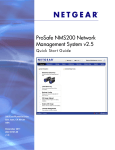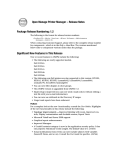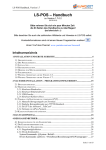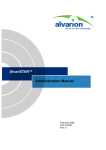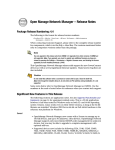Download Dell OpenManage Network Manager User guide
Transcript
Dell OpenManage Network Manager Version 5.3 Service Pack 2 Quick Start Guide Notes and Cautions A NOTE indicates important information that helps you make better use of your computer. A CAUTION indicates either potential damage to hardware or loss of data and tells you how to avoid the problem. ____________________ © 2010-2014 Dell Inc. Trademarks used in this text: Dell™, the DELL logo, Dell Precision™, OptiPlex™, Latitude™, PowerEdge™, PowerVault™, PowerConnect™, OpenManage™, EqualLogic™, KACE™, FlexAddress™ and Vostro™ are trademarks of Dell Inc. Intel®, Pentium®, Xeon®, Core™ and Celeron® are registered trademarks of Intel Corporation in the U.S. and other countries. AMD® is a registered trademark and AMD Opteron™, AMD Phenom™, and AMD Sempron™ are trademarks of Advanced Micro Devices, Inc. Microsoft®, Windows®, Windows Server®, MSDOS® and Windows Vista® are either trademarks or registered trademarks of Microsoft Corporation in the United States and/or other countries. Red Hat Enterprise Linux® and Enterprise Linux® are registered trademarks of Red Hat, Inc. in the United States and/or other countries. Novell® is a registered trademark and SUSE ™ is a trademark of Novell Inc. in the United States and other countries. Oracle® is a registered trademark of Oracle Corporation and/or its affiliates. Citrix®, Xen®, XenServer® and XenMotion® are either registered trademarks or trademarks of Citrix Systems, Inc. in the United States and/or other countries. VMware®, Virtual SMP®, vMotion®, vCenter®, and vSphere® are registered trademarks or trademarks of VMWare, Inc. in the United States or other countries. Other trademarks and trade names may be used in this publication to refer to either the entities claiming the marks and names or their products. Dell Inc. disclaims any proprietary interest in trademarks and trade names other than its own. 2014 Rev. A04 Introduction The following sections outline the steps to install a typical Dell OpenManage Network Manager system and its subsequent first use. Because the software described here is both powerful and flexible, this quickstart cannot describe all the details of available installations. Instead, this Guide refers to those descriptions elsewhere or in online help. It also includes a Pre-Installation Checklist, below. A typical installation includes the following: • • • • • • • • Installing and System Startup Configuring Dell OpenManage Network Manager Users Discover Your Network Resource Management File Management Fault Management - Problem Diagnosis Performance Management - Troubleshooting Reports Pre-Installation Checklist The following helps you avoid trouble in your Dell OpenManage Network Manager installation. Pre-Installation • • • • • Select devices (IP addresses) and ports to monitor. Select IP address for your server. • Configure its IP address as a management station and receiver of SNMP traps on each device. Determine IP range of devices being discovered. Verify firewalls have open ports between devices and your server. Best practice is to take down the firewall, install the application, then put it back up. Review device documentation and release notes. 1 Other Software to Install Install these: ActivePerl (then reboot your host), Latest Adobe Flash player, Latest Adobe Reader. You will also need access to an FTP / TFTP server. NOTE: You must disable User Account Control if installing on Windows Server 2008. Temporarily disable the system firewall or any anti-virus software prior to installing, too. Install this software and the wizard will walk you through initial setup. Dell OpenManage Network Manager installs as a service and starts automatically. Refer to the User Guide and release notes for additional setup information. Installation Installation host—Log in as an administrative user. An administrative user can write to the installation target directory. Do not log in with user name admin, administrator, or a name that contains spaces on Windows, or as user root on Linux Windows 2012 —When installing on this platform, right click win_install.exe and select Properties > Compatibility. Select compatibility mode for Windows 7 /Vista. Directories—The source directory should not be the same as installation target directory Fixed IP Address—Dell OpenManage Network Manager requires a static IP address. CAUTION: You must have root access to install on Linux, but do not install as user root (or user dorado). Starting Dell OpenManage Network Manager (After installation) Database Running, Connected—Make sure your database is running. MySQL installs automatically as a service (daemon).. Do not install on Linux with MySQL already installed (uninstall any included MySQL first). Start Application Server—If you installed this software as a service and application server is down, in Windows right-click the startappserver icon, and start application server. This icon may prematurely indicate application server has started. Workaround: Wait a little, and the application server will catch up to the icon. When initiated from the tray icon, startup changes its color from red to yellow to green, when complete. Once the icon has turned green, the web client may display the message “The server is currently starting up. This page will refresh when the server has fully started.” This message indicates the application server requires extra time to start. When the message does occur connect the web browser again after a few minutes. 2 Login—Default Dell OpenManage Network Manager login is admin, password admin. CAUTION: The first time you start the application after you install it, you may have to wait some additional minutes for Application to completely start. One indication you have started viewing your web client too soon is that the Quick Navigation portlet does not appear properly. Workaround: Force Redcell to re-initialize the admin user. To do that: Login as Admin. Go To > Control Panel > Users and Organizations. Select and edit the Admin user. Edit any field (Middle Name for example). Save. Sign out. Log back in with admin. For Successful Discovery (After startup) Have the Following: Connectivity—Ensure application server has connectivity to devices to discover. One easy way to do this is to ping the discovery target from application server. Device Login/Passwords— Needed for discovery targets. Typically these include SNMP communities and CLI login / password combinations. Determine what version of SNMP you are using, too. Device Access—Insure Dell OpenManage Network Manager’s host is authorized to manage to the device(s). When necessary, configure devices’ ACLs to admit this application’s access / management. Backup / Restore / Deploy (After device discovery) FTP/TFTP Server—Make sure an external FTP/TFTP server is running and has network access to the target device(s). Typically FTP/TFTP servers must be on the same side of firewalls as managed devices. Dell OpenManage Network Manager’s internal FTP/TFTP server is for testing only. If these are separate processes, configure them so they write to the same directory. Alarms / Monitoring Minimize Network Traffic—Configure “chatty” devices to quiet down. Use Suppress Alarms to keep performance at acceptable levels, and configure database archiving so the database does not fill up. NOTE: Some Dell OpenManage Network Manager features do not work without internet access. In particular: Maps, because the maps Dell OpenManage Network Manager uses need internet access to retrieve maps and plot locations. But if you do not need functioning map portlet(s), then running Dell OpenManage Network Manager without internet access works well as long as the network is properly configured and resolves the localhost name to application server’s IP address. Licenses and Upgrades Dell OpenManage Network Manager 5.3 can only be installed as an initial installation or upgraded from version 5.0 or later. 3 Recovering licenses—Dorado Software can provide licenses to replace any lost or misplaced licenses on request. This can be done by contacting your sales representative or going to http:// www.doradosoftware.com/dell/upgrade-info.html. Refer to the User Guide and Release Notes for additional information. You can contact the Sales rep that provided the license, contact Dorado Software, call the Dorado Software help desk, or submit a trouble ticket requesting a license upgrade. When you license new features, you must restart the application server. Installing and System Startup Initiate installation by clicking Install by executing the shortcuts to win_install.exe [Windows], or linux_install.sh [Linux] in the installation root directory. Click through the installation wizard, accepting the license and making the appropriate entries. During installation, one screen lets you select the application’s memory size. Best practice is to select the largest available after 1 - 4 GB is set aside for the operating system. NOTE: You can re-set the selected memory size after installation too, with the following properties in \owareapps\installprops\lib\installed.properties: oware.server.min.heap.size=1024m oware.server.max.heap.size=1024m When you have installed and successfully deployed Dell OpenManage Network Manager, you can continue to the next steps. See the Installation and Startup section of the Dell OpenManage Network Manager User Guide for step-by-step instructions for a typical installation. For more complex installations, consult the Dell OpenManage Network Manager’s Administration Section of the User Guide. Finally, you must do the following to see Dell OpenManage Network Manager: 1 If your application server is not running, manually start it. You can use the Start > Programs > Dell OpenManage Network Manager menu in Windows, or simply type startappserver in a command shell. If it is installed as a service, and the tray icon is red, right-click that icon and select Start. Application server monitors your network even when the client is not running. 2 If it is not already running, start the web server. Right-click the tray icon for web server and select Start service. NOTE: On Linux start (or stop) the webserver with scripts startportal.sh start (or startportal.sh stop) located in the oware/synergy/tomcat-x.x.x/bin directory. 4 3 To see the client interface, open a browser, and enter this in the URL field: http://[hostname or host IP address]:8080. Internet Explorer 9 or above, if set up in compatibility mode with Internet Explorer 7 or Internet Explorer 8 has difficulties rendering the user interface. 4 Log in for the first time as admin (password admin). 5 Dell OpenManage Network Manager should appear with the standard set of page configurations for your package. You can typically reconfigure these defaults. See the User Guide for guidance about how to do that. NOTE: Instead of oware, in Linux systems type . /etc/.dsienv —[dot][space]/etc/[dot]dsienv) Configuring Dell OpenManage Network Manager Users As an Administrator, you can configure Users, and Roles to identify support teams (examples: administration, engineering and operations) and configure permissions. After creating them, add Users to roles which configure their permissions for access and action. The following describes how to do this. Add Users and connect them to Roles Add Users with the following steps: 1 Click Go to > Control Panel and navigate to Portal > Users and Organizations. 2 Click the Add > User menu item at the top of the Users and Organizations screen. 3 Enter the details of the new user. If you are editing an existing user, more fields appear. Screen Name, and Email Address are required. Optionally, you can enter Name, Job Title, and so on. 4 After you click Save notice that the right panel expands to include additional information. Make sure you specify a Password. 5 Notice that if you are editing an existing user, or creating a new one, you can use the links on the right to configure connections with Roles. Roles, in particular, configure the Dell OpenManage Network Manager functional permissions for that user. For example the group of Operators would likely have more limited capabilities than Administrators. 6 Click Save again, and the user you just configured should appear listed in the Users and Organizations screen when you select View > All Users. 5 7 To assign a user to a role, click Action > Permissions and check the appropriate box next to the role. Configure Dell OpenManage Network Manager functional permissions for these roles in Roles. Add and Configure User Roles / Permissions Add and configure User Roles with the following steps: 1 Click Go to > Control Panel and navigate to Portal > Roles. 2 Click the Add tab under the heading at the top of the page, and select Regular Roles. Notice that you can also add roles that configure permissions for sites and organizations. 3 Enter the details of the new role (Name, Title, Description), then Save it. 4 Click Portal > Roles’ View All button to see a list of available roles, including the one you added. 5 By clicking the Action icon to the right of any listed Role, you can also select the role’s permissions to alter web portal access in a subsequent screen. 6 Click Add to add permissions. Click the checkboxes to enable the type of permission desired. 7 To do more with Dell OpenManage Network Manager’s functional permissions, go to the Redcell > Permission Manager, and click to open this screen. 8 The Role to Permission mapping screen appears. Click the Edit button to the right of listed Roles to see and configure available permissions. 9 Click Advanced to see available permissions organized by Read, Write, Execute, Add or Delete actions. 10 After you have selected permissions, click Apply to accept them and add them to the role. Notice that you can revisit this role, manage it and its membership with the Action button to the right of the role. You can also add users to the group by selecting and editing that user. CAUTION: The first time you start the application after you install it, you may have to wait an additional five minutes for Application to completely start. One indication you have started too soon is that the Quick Navigation portlet does not appear properly. Also: Web server may indicate it has fully started before it is entirely ready. In rare instances, this may also inhibit correct communication with the client interface. If Dell OpenManage Network Manager appears stuck after application server is running completely, restart the web server. Discover Your Network To begin managing resources in your network, you must discover them to store their information in the application database. This begins either with the Resource Discovery Quick Navigation button or the Discovery Profiles portlet. 6 Discovery profiles configure equipment discovery for Dell OpenManage Network Manager. The summary view displays the Name, Description, Default (the green check indicates the default profile), whether the profile is Scheduled and Next Execution Date for scheduled discovery. Follow these steps to start discovering equipment on your network. 1 Click the Resource Discovery button in Quick Navigation or right-click the Discovery Profiles list and select New. (If you have previously exported profiles, you can Import them. You can also Export Selection, or Export all profiles in this manager. Open an existing profile to edit it.) 2 After this beginning, if you clicked the Resource Discovery button, the Quick Discovery screen appears where you can enter device identifiers (typically IP Address(es)), and authentications, then execute discovery. The Quick Discovery screen can also discover the default Discovery profile if you have configured one already. If you clicked New in the Discovery portlet, the Discovery Profile Editor appears, with a stepby-step set of screens to configure resource discovery, as described below. You can navigate through the Profile Editor by clicking the screen tab names at the top, or by clicking the Next button at the bottom of the page. Discovery Profile Editor Use this editor to configure discovery. Follow these steps to discover equipment on your network: General 3 General Parameters—Set the Name, Description. 4 Profile Options—Select the Device Naming Format (how the device appears in lists, once discovered), whether to Manage by IP address or hostname, and check whether to Resolve Hostname(s), ICMP Ping Device(s), Manage ICMP-only Device(s), or Manage Unclassified Device(s). This last checkbox determines whether Dell OpenManage Network Manager attempts to manage devices that have no device driver installed. Management may be possible, but more limited than for devices with drivers installed, provided this capability is one you have licensed. 7 The Filters (by Location, Vendor, or Device Type) let you narrow the list of devices discovered by the selected item(s). As the screen says, this filtering will not have any impact on the processing that occurs during the Inspection step. CAUTION: Model numbers may change when you upgrade. You may need to change any pre-existing filters that refer to model numbers. These may not change until you perform a resync on some devices. Network 5 After you click Next, the Network screen appears. Network Type and Addresses— Select the type of entry in the pick list (IP Address(es), CIDR Address, Hostname, SNMP Broadcast, Subnet). NOTE: You can specify an IP Address range by separating the beginning and end with a dash. For example: 192.168.1.1-192.168.1.240. The tooltips in the data entry field describe what valid entries look like. 6 Authentication—You can Create new, or Choose existing authentications. Notice that authentications appear with Edit / Delete icons and Up / Down arrows on their right. The Edit icon opens the authentication editor. Click the arrows to arrange the order in which credentials are tried (top first). Ordering only applies when two credentials are of the same type. NOTE: Discovery can fail because of network latency / timeout issues. Increasing the timeout or retries for Dell OpenManage Network Manager authentications can circumvent that. Actions 7 You can configure Actions to run as part of discovery. By default, the actions screen includes several, including the Resync action. Use Add Action to select others to enter here. You can also edit parameters (if available), delete and re-order the actions listed here by clicking the icons to the right of them. Dell OpenManage Network Manager executes them in top-tobottom order. Inspection 8 Inspect Network using your current settings—This screen lets you preview the discovery profile’s actions and access to devices. If you clicked Next rather than Inspect at the bottom of the previous screen, click Start Inspection to begin the inspection process for selected authentications that validates the device’s credentials. Notice that the Auth Test Status fields below listed authentications indicates the success or failure of Ping, Hostname resolution, and the listed Authentications. 8 If the device does not match all required authentications, you can click the Fix it icon (wrench and screwdriver crossed) to edit them for the selected device. You can also click Test Device, Create New, or Choose Existing authentications while in the editor clicking the Fix it icon displays. When authentications are unsuccessful, you can remove or edit them in this editor too. Click the icons to the right of listed authentications to do this. 9 Save—Click Save to preserve the profile. You can then right-click it to select Execute and begin discovery. If you select Execute from the profile editor, Dell OpenManage Network Manager does not save the profile to execute later. Results 10 Execute—Clicking Execute begins discovery, and the message traffic between Dell OpenManage Network Manager and the device appears on the Results screen. This is a standard Audit screen. 11 A message (Discovery Profile Execute is complete) appears in the Messages at the bottom left of the status bar. NOTE: You can also schedule discovery profiles to run periodically, updating your Dell OpenManage Network Manager database with any network changes. 12 The devices in your network now appear in the Resource Management portlet, and elsewhere (in Topology, for example). Resource Management The Managed Resource portlet displays all the devices you have discovered. Right-clicking a listed resource displays a menu with options described in the User Guide. 9 Common Setup Tasks If this portlet does not appear on the first page after you sign in, you can add it. It offers you a convenient wayt to do the following setup tasks: • SMTP Configuration— This configures how Dell OpenManage Network Manager sends notification e-mails. Netrestore File Servers— See Configure an FTP/TFTP Server on page 11 below.. A red flag appears with the “Setup required” message in the Status column when these are not configured. Configuring them displays a green flag with the “Setup complete” message. Click the edit link in the Action column to open editors for each of these. Quick Navigation The Quick Navigation portlet lets you quickly click some links to basic tasks: Resource Discovery—Discover devices in your network with the Quick Discovery defaults, or lets you construct a Quick Discovery profile if none exists. See the User Guide for details. Link Discovery—After you have discovered resources, this discovers their connections. Backup Config Files— This lets you back up discovered devices’ configuration files. Before you can use this feature, you must have FTP / TFTP servers configured. OS Image Upload— Upload firmware updates for devices. Deploy OS Image— This deploys firmware updates. To deploy images, you must have FTP / TFTP Servers configured. License Management— This lets you see, update and manage the licensed capabilities of Dell OpenManage Network Manager. File Management Dell OpenManage Network Manager lets you manage device configuration files. Before you begin that management, you must first do the steps described in Configure an FTP/TFTP Server on page 11 to get or send such configurations from / to devices. After doing the steps described in that section, you can do Do Configuration File Backup / Restore on page 11 below. 10 Configure an FTP/TFTP Server Follow these steps to configure an FTP / TFTP server: 1 Right-click and select New in the File Servers portlet. 2 After entering all required details click Save to save new file server. 3 Click Test to validate the new file server is working. Do Configuration File Backup / Restore Provided you have permissions, you can backup configuration file(s) for a single device or group of devices, either on demand or as scheduled. Follow these steps: 1 In the default Dell OpenManage Network Manager screen layout, in the Managed Resources portlet, select (click on) a Managed Resource of interest. 2 Right-click on selected resource in the Managed Resources portlet, and then click File Management > Restore or Backup. 3 Enter the information needed to create the backup or restoration. 4 Optionally click Add Schedule to schedule the backup task. 5 Click Execute to immediately do backup or Save to save the configured backup to run later. Deploy a single configuration to many target devices The following steps describe deploying a single configuration to many discovered devices without overwriting those devices’ essential information. 1 Back up a single device’s configuration. 2 Right-click this backed up file in the File Management portlet, and Promote it so it appears in the Image Repository portlet. 3 Right-click > Edit the promoted configuration in the Image Repository. 4 Name the file, and, if necessary, configure a filter In the General Parameters tab of the editor. 5 In the Configuration tab, locate the parameters you want to preserve in discovered devices when you restore this file. This can include items like the device’s DNS Hostname, IP Address, and so on. Delete the file’s specifics and double-click to insert the Target Params in place of these variables. 6 Save the configuration. 7 Right-click to deploy this configuration. 8 You can check Generate and save for configuration only if you simply want to configure deployment for later, and save for now. You can also optionally name a label for the deployed files. 9 Select the devices, or groups of devices to which you want to deploy. 11 10 Click Save, Execute or Add Schedule depending on your desired outcome. 11 If you click Execute, you will have to confirm this action. When Dell OpenManage Network Manager performs the restoration (deploy), it reads the Target Params from those discovered for each device, inserts those in the config file, then restores it, device by device, skipping any that do not pass the filter set up in step 4. Fault Management - Problem Diagnosis Dell OpenManage Network Manager lets you diagnose network problems with its Alarms viewer, and lets you monitor performance with its Performance Management - Troubleshooting capabilities, as described below. The following briefly outlines these capabilities Alarms Alerts about network performance issues can include alarms about the following: • • • • • Excessive interface utilization Unexpectedly high CPU load Loss of available memory Slow response time Excessive interface errors When you receive an alarm you can take any of the following action on the alarm itself, or the target of the alarm: • Assign User 12 • • • • Acknowledge Alarm Unacknowledge Alarm Clear Alarm Show Performance Follow these steps to get started: 1 Click to go to the Alarms page from the default screens. 2 In the Alarms portlet, click on an Alarm of interest. NOTE: If your Alarms portlet displays a graph of different alarm types, clicking on s particular alarm severity filters the list below to only display that severity. Click again to undo the filter effect. 3 Right-click on the selected alarm, and then click Acknowledge Alarm to take ownership of the alarm. 4 Right-click then click Assign User to select a user owner for the alarm. 5 Right-click then click Clear Alarm to remove the alarm from list. 6 Click the plus (+) in the upper right corner of the Alarms portlet to go into Expanded mode where you can view more details about an alarm. Performance Management Troubleshooting In addition to troubleshooting faults, you can also monitor device performance with Dell OpenManage Network Manager. Monitors Monitors display some critical performance metrics for devices on the network, including: •Network availability •Bandwidth capacity utilization •Buffer usage and errors •CPU and memory utilization •Interface errors and discards •Network latency •Node and interface status To get started using monitors, follow these steps: Resource Monitors portlet on that page. 1Click the Performance page, and find the 13 2 Hover the cursor over a Monitor of interest to see a tooltip of details about it. 3 Click to select a Monitor of interest. 4 Right-click the selected monitor in the Resource Monitors portlet, and then click Open to edit its details, including enabling/disabling it. Dashboard Views With permissions, you can view the performance data collected by the monitors, in graphical and tabular form including: • • • • • Excessive interface utilization Unexpectedly high CPU load Loss of available memory Slow response time Excessive interface errors To view this data, follow these steps: 1 Click the Performance > Top N page and find the Top Problem Nodes portlet. 2 Hover the cursor over a Device/Interface of interest to see a tooltip of details about its status. 3 Right-click and select Show Key Metrics, or Show Performance which opens a dashboard. Reports You can use the Reports to troubleshoot and monitor performance and historical data that has been collected during the operation of the network. With the correct permissions, you can run Inventory Reports on demand or as scheduled. If you want to automate month-end reports Dell OpenManage Network Manager lets you schedule either recurring reports or a single scheduled occurrence. 1 Find the Reports portlet. 2 Click to select a Report of interest. 3 Right-click, and then click Execute to run report 4 Report generation runs in the background. When it is complete, a message appears in the Alerts tab at the bottom left corner. 5 Click on the Alerts tab to open it, then click on the Report of interest and click on the View Details icon at the right end of entry, to view completed report. 14

















